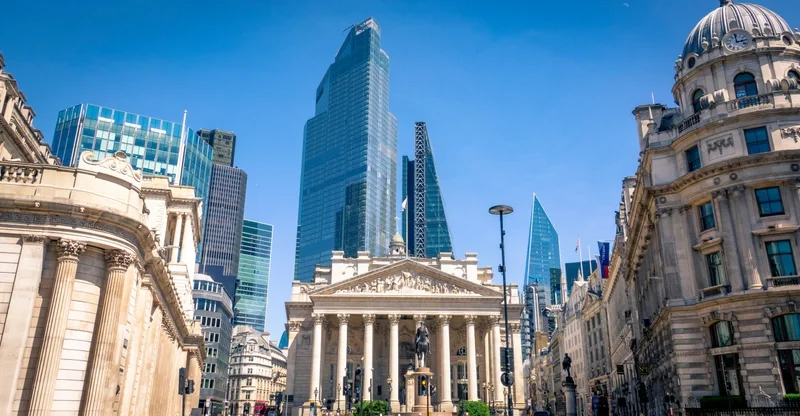
UK inflation fell to an 18-month low driving London’s stocks higher on Wednesday, with top housebuilders doing particularly well, as nerves calmed ahead of this week’s upcoming rate announcements.
The FTSE 100 index opened up 44.27 points, 0.6%, at 7,704.47. The FTSE 250 was up 240.40 points, 1.3%, at 18,667.10, and the AIM All-Share was up 2.26 points, 0.3%, at 744.67.
The Cboe UK 100 was up 0.7% at 768.06, the Cboe UK 250 was up 1.4% at 16,280.86, and the Cboe Small Companies was up 0.4% at 13,435.85.
In European equities on Wednesday, the CAC 40 in Paris was marginally lower while the DAX 40 in Frankfurt was up 0.4%.
The UK headline inflation unexpectedly cooled last month, as stubborn core price pressure finally eased, figures from the Office for National Statistics showed. Market forecasts had been expecting inflation to creep back up, amid the rising cost of fuel.
Annually, UK consumer prices rose by 6.7% in August, easing from a 6.8% rise in July. August’s reading undershot market forecasts, as cited by FXStreet, which had predicted the inflation rate to heat up to 7.1%.
The annual core inflation rate - which excludes energy, food, alcohol and tobacco - cooled to 6.2% in August, from July’s reading of 6.9%. August’s reading had been expected to come in at 6.8%.
‘Within half an hour what had been a pretty nailed on 80% expectation of another quarter percentage point hike fell to a 50/50 chance that [BoE Monetary Policy Committee] members would vote to press pause on this rate hiking cycle, at least for now,’ said Danni Hewson, AJ Bell head of financial analysis.
The pound dropped suddenly after the reading, with sterling quoted at $1.2354 early Wednesday, down from $1.2399 at the London equities close on Tuesday.
In the FTSE 100, shares in housebuilders jumped, as investors priced in the prospect of lower mortgage rates. Taylor Wimpey added 5.3% and Barratt rose 5.2%, while in the FTSE 250 Persimmon, Crest Nicholson and Vistry added 5.1%, 4.3%, and 3.5% respectively.
Another strong performer in the FTSE 100 was M&G, up 3.4%.
M&G said insurance revenue climbed to £1.82 million annually in the six months to June 30, from £1.78 billion. The investment manager swung to a pretax profit of £128 million from £1.77 billion loss. Assets under management & administration fell to £332.8 billion from £348.9 billion a year before.
M&G said the interim results ‘underpin [its] confidence’ in delivering its core priorities and financial targets, with M&G remaining on track to achieve its operating capital generation target of £2.5 billion by the end of 2024. It lifted its interim dividend to 6.5p from 6.2p.
Of a handful of blue chip companies trading in the red were BP and Shell, down 0.6% each. Oil prices eased somewhat overnight, with Brent oil fetching $93.36 a barrel early Wednesday compared with $95.20 late Tuesday.
This will likely be a relief to monetary policymakers the world over, as the latest rebound in oil prices has been fuelling fears of renewed upward pressure on costs.
Pearson sank 5.3% as the publisher announced Omar Abbosh will become its new CEO early next year, with Andy Bird retiring after three years in the role. Abbosh is president of Microsoft’s Industry Solutions Business.
While London’s equities got a lift from the UK inflation print, the mood elsewhere was more cautious ahead of the US interest rate announcement.
The Federal Open Market Committee will announce its interest rate decision at 1900 BST on Wednesday. A press conference with Chair Jerome Powell will follow shortly after. According to the CME FedWatch Tool, there is a 99% chance the central bank will leave the federal funds rate range unchanged at 5.25% to 5.50%.
Consequently, the market will be focusing on the guidance about any future rate hikes, or even any hints for when rates will be cut. The Fed will also release its dot plot as part of its economic forecasts, which will provide its projections for interest rates, economic growth and inflation.
‘The policymakers will likely sound satisfied with the progress on inflation, and they could revise their growth forecasts significantly higher. Strong growth forecast could trigger a fresh wave of hawkish trades across stock, bond, and currency markets,’ said Swissquote Bank senior analyst Ipek Ozkardeskaya.
However, she contends that the Fed’s forecasts should be taken ‘with a pinch of salt’, given the central bank’s track history of being ‘utterly wrong’ in its forecasts for inflation, unemployment and growth.
‘If [the Fed revised growth forecasts higher], they will be wrong once again, because underneath the shiny picture, the US savings are melting, the credit card delinquencies are rising, student debt repayments will start in October – that should put some pressure on spending, hence on growth, then the Detroit strikes threaten to further destabilise growth,’ Ozkardeskaya predicted.
The dollar was stronger against major currencies in early exchanges in Europe.
The euro traded at $1.0683 early Wednesday, lower than $1.0691 late Tuesday. Against the yen, the dollar was quoted at JP¥147.96, up versus JP¥147.71.
Japan’s top currency official Masato Kanda told reporters Japan is ‘closely cooperating with the authorities abroad, the US authorities, and sharing views that excessive movement (in the foreign currency exchange rate) is undesirable’.
‘We are observing (the market) with a sense of urgency and will take appropriate measures without ruling out any means against excessive movement,’ he said.
In Asia on Wednesday, the Nikkei 225 index in Tokyo closed down 0.7%, as data revealed a sharp annual drop in Japanese imports in August, helping to narrow the country’s trade deficit. Exports to China, one of Japan’s major trading partners, dropped 11%, as total exports edged down 0.8%.
In China, the Shanghai Composite closed down 0.5%, while the Hang Seng index in Hong Kong was down 0.6% in late dealings.
China’s central bank left key interest rates unchanged on Wednesday, as widely expected. The one-year loan prime rate, which serves as a benchmark for corporate loans, was maintained at 3.45%, the People’s Bank of China said in a statement. It had been cut from 3.55% in August, in an attempt to counter the post-Covid growth slowdown in the world’s second-largest economy.
The five-year LPR, which is used to price mortgages, was held at 4.2%.
According to SPI Asset Management’s Stephen Innes, the move to keep rates was ‘particularly risk-averse, given the property concerns’ in the country.
‘We could be nearing the point where traders throw in the towel on expectations of more significant stimulus or a substantial improvement in economic momentum,’ he added.
The S&P/ASX 200 in Sydney closed down 0.5%.
In the US on Tuesday, Wall Street ended in the red, with the Dow Jones Industrial Average down 0.3%, the S&P 500 down 0.2% and the Nasdaq Composite down 0.2%.
Gold was quoted at $1,930.20 an ounce early Wednesday, lower than $1,933.01 on Tuesday.
Copyright 2023 Alliance News Ltd. All Rights Reserved.




